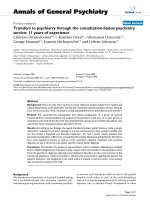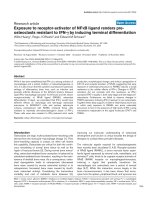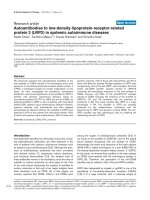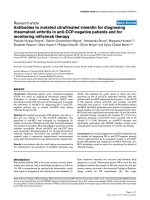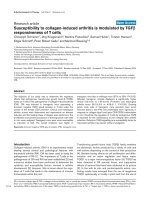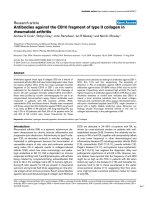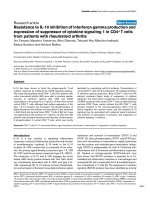Báo cáo y học: "Antibodies to mutated citrullinated vimentin for diagnosing rheumatoid arthritis in anti-CCP-negative patients and for monitoring infliximab therapy" ppt
Bạn đang xem bản rút gọn của tài liệu. Xem và tải ngay bản đầy đủ của tài liệu tại đây (179.01 KB, 7 trang )
Open Access
Available online />Page 1 of 7
(page number not for citation purposes)
Vol 10 No 6
Research article
Antibodies to mutated citrullinated vimentin for diagnosing
rheumatoid arthritis in anti-CCP-negative patients and for
monitoring infliximab therapy
Pascale Nicaise Roland
1
, Sabine Grootenboer Mignot
1
, Alessandra Bruns
2
, Margarita Hurtado
1,3
,
Elisabeth Palazzo
2
, Gilles Hayem
2
, Philippe Dieudé
2
, Olivier Meyer
2
and Sylvie Chollet Martin
1,3
1
Immunology and Haematology Department, Bichat-Claude Bernard Teaching Hospital, AP-HP, 46, rue H Huchard 75877 Paris Cedex 18, France
2
Rheumatology Department, Bichat-Claude Bernard Teaching Hospital, AP-HP, 46 rue H Huchard 75877 Paris Cedex 18, France
3
Inserm IFR 141, UMR756, Paris-South 11 University, 5 rue JB Clement 92296 Chatenay-Malabry Cedex, France
Corresponding author: Pascale Nicaise Roland,
Received: 15 Jul 2008 Revisions requested: 12 Aug 2008 Revisions received: 26 Nov 2008 Accepted: 10 Dec 2008 Published: 10 Dec 2008
Arthritis Research & Therapy 2008, 10:R142 (doi:10.1186/ar2570)
This article is online at: />© 2008 Nicaise Roland et al.; licensee BioMed Central Ltd.
This is an open access article distributed under the terms of the Creative Commons Attribution License ( />),
which permits unrestricted use, distribution, and reproduction in any medium, provided the original work is properly cited.
Abstract
Introduction Antibodies against cyclic citrullinated peptides
(CCPs) are useful for diagnosing rheumatoid arthritis (RA).
Antibodies to mutated citrullinated vimentin (MCV) were
described recently in RA. The aims of this study were to evaluate
the usefulness of anti-MCV for diagnosing RA in anti-CCP-
negative patients and to monitor anti-MCV titres during
infliximab therapy for RA.
Methods We studied two groups of RA patients, one with (n =
80) and one without (n = 76) anti-CCP antibodies. The
specificity of anti-MCV was evaluated by investigating 50
healthy controls and 158 patients with other rheumatic diseases
(51 psoriatic rheumatism, 58 primary Sjögren syndrome, and 49
ankylosis spondylitis). Serum anti-MCV and anti-CCP titres
were measured in 23 patients after 6, 12, 18, and 24 months of
infliximab treatment. Anti-CCP2 and anti-MCV levels were
assayed using a commercial enzyme-linked immunosorbent
assay. IgM rheumatoid factor was determined by nephelometry.
Results In accordance with the cutoff values recommended by
the manufacturer, the specificity of anti-MCV antibodies was
90.9%. We adjusted the cutoff values to obtain the same
specificity as that of anti-CCP antibodies (94.2%). With this
optimal cutoff, anti-MCV antibodies were found in 11.8% (9/76)
of RA patients without anti-CCP, and similarly, anti-CCP
antibodies were found in 11.2% (9/80) of RA patients without
anti-MCV. Anti-MCV antibodies were positive in 6 patients who
tested negative for both anti-CCP and rheumatoid factor. Anti-
MCV titres were significantly decreased after 18 and 24 months
of infliximab therapy compared with baseline (P < 0.01) as a
significant decrease of anti-CCP levels occurred only at 24
months (P < 0.04). Moreover, an anti-MCV decrease was
significantly associated with DAS28 (disease activity score
using 28 joint counts) improvements 12 months into therapy.
Conclusions Our results suggest that anti-MCV antibodies may
be valuable for diagnosing RA in anti-CCP-negative patients
without replacing them as an equivalent number of anti-CCP-
positive RA patients test negative for anti-MCV. Moreover, anti-
MCV antibodies could be useful for monitoring the effects of
infliximab therapy.
Introduction
Rheumatoid arthritis (RA) is the most common chronic inflam-
matory joint disease, with a worldwide prevalence of 0.5% to
1%. RA is characterized by synovial joint inflammation, which
often leads to progressive joint destruction and disability [1].
Early treatment improves the outcome and therefore early
diagnosis is crucial. Rheumatoid factors (RFs) were the first
biological markers discovered for RA and remain the only lab-
oratory criterion included in the American College of Rheuma-
tology criteria for RA classification [2]. Two major
ACR: American College of Rheumatology; AKA: anti-keratin antibody; APF: anti-perinuclear factor; CCP: cyclic citrullinated peptide; DAS28: disease
activity score using 28 joint counts; DMARD: disease-modifying antirheumatic drug; EIA: enzyme immunoassay; ELISA: enzyme-linked immunosorb-
ent assay; MCV: mutated citrullinated vimentin; PTPN22: protein tyrosine phosphatase nonreceptor type 22; RA: rheumatoid arthritis; RF: rheumatoid
factor; TNF: tumor necrosis factor.
Arthritis Research & Therapy Vol 10 No 6 Roland et al.
Page 2 of 7
(page number not for citation purposes)
disadvantages of RF are low specificity and possible absence
in the first year of the disease [3]. Several other auto-antibod-
ies specific to RA have been found. Among them, anti-filaggrin
antibodies, anti-keratin antibodies (AKAs), and anti-perinu-
clear factor (APF) exhibit a high specificity and sometimes
present early in the disease. However, AKA is not sufficiently
sensitive to be used for diagnosing RA. APF detection is avail-
able only at specialized laboratories, as obtaining and stand-
ardizing the substrate is technically challenging, and
interpreting the immunofluorescence results is largely subjec-
tive [4].
Anti-filaggrin antibodies recognize citrulline residues formed
by post-transcriptional modification of arginine by peptidy-
larginine deiminase [5]. Enzyme immunoassays (EIAs) based
on synthetic cyclic citrullinated peptides (CCP2) are available
for detecting anti-CCP. We and others previously showed that
the sensitivity of these antibodies was about 80% in estab-
lished RA [6,7] compared with 55% in early RA [6,8] and 40%
in very early RA [9,10]. The usefulness of anti-CCP for moni-
toring RA patients, particularly during treatment, is controver-
sial. A significant decrease was found after 6 months of tumor
necrosis factor (TNF) antagonist therapy in one study [11],
whereas decreases were slow and inconsistent during inflixi-
mab therapy in two other studies [12,13].
Antibodies to other citrullinated peptides or proteins have
been suggested as good candidates for diagnosing RA.
Vimentin is an intermediate filament that is widely expressed
by mesenchymal cells and macrophages and easy to detect in
the synovium. Modification of the protein occurs in macro-
phages undergoing apoptosis, and antibodies to citrullinated
vimentin may emerge if the apoptotic material is inadequately
cleared [14]. The first antibodies to citrullinated vimentin
described in the literature were anti-Sa antibodies detected by
Western blot, which were as specific as anti-CCP but not suf-
ficiently sensitive (20% to 45%) to serve as diagnostic tools
[15,16]. Recombinant mutated citrullinated vimentin (MCV)
was recently produced, and an enzyme-linked immunosorbent
assay (ELISA) was developed for detecting anti-MCV. Few
data are available on the performance of anti-MCV for diagnos-
ing RA. In most studies, anti-MCV and anti-CCP testing pro-
duced similar results [17-20]. Two studies, however,
suggested that anti-MCV might be more sensitive than anti-
CCP [21,22].
The aims of this study were to evaluate the usefulness of anti-
MCV for diagnosing RA in anti-CCP-negative patients and to
monitor anti-MCV titres during infliximab therapy for RA. First,
we compared the results of anti-MCV tests in RA patients with
and without positive tests for anti-CCP. Then, we obtained
serial anti-MCV assays in RA patients receiving infliximab ther-
apy.
Materials and methods
Patients
We studied 156 patients seen at the Rheumatology Depart-
ment of the Bichat-Claude Bernard Teaching Hospital (Paris,
France) for RA meeting American College of Rheumatology
(ACR) criteria. Among them, 20 had early RA (<12 months).
The control group was composed of 50 healthy controls and
158 patients seen at the same department for other diseases,
including psoriatic arthritis (n = 51), primary Sjögren syndrome
(n = 58), and ankylosing spondylitis (n = 49).
Among the RA patients, 23 were evaluated after 6, 12, 18, and
24 months of infliximab therapy. All 23 patients had a history
of inadequate response or tolerance to at least one conven-
tional disease-modifying antirheumatic drug (DMARD). Previ-
ous treatment with DMARDs (methotrexate,
hydroxychloroquine, azathioprine, or sulfasalazine), steroids,
and nonsteroidal anti-inflammatory drugs could be continued
provided that the dosage was kept stable for at least 4 weeks
before infliximab initiation and throughout infliximab therapy.
Infliximab was administered (3 mg/kg) at baseline, 2 and 6
weeks later, and every 8 weeks thereafter in combination with
a DMARD. None of the patients had active or latent tuberculo-
sis, other infections, or severe comorbidities.
The following variables were collected at baseline and then
after 3, 6, 12, 18, and 24 months: tender and swollen joint
counts of a total of 28 joints, score on a visual analog scale for
global health completed by the patient, erythrocyte sedimenta-
tion rate, and C-reactive protein level. The disease activity
score using 28 joint counts (DAS28) was computed at 0, 6,
and 12, months; the amount of missing data was too large for
reliable DAS28 determination at the 3-month time point.
Responders were defined at different time points as having a
DAS28 decrease of greater than 1.2 with a DAS28 value of
less than 3.2, and nonresponders were defined as having a
DAS28 decrease of less than 0.6 or a decrease in the 0.6 to
1.2 range with a score value of greater than 5.1 [23]. Data for
responders and nonresponders were compared only at 6 and
12 months as the number of nonresponder patients available
at 18 and 24 months was too low for a statistical analysis.
The patients were informed of the purpose of the study and
gave their informed consent. The trial was approved by the
ethics committee of our hospital. All procedures were con-
ducted in accordance with the hospital's ethics rules. All the
sera were stored at -20°C until the assays.
Methods
IgM-RF was determined by nephelometry using a BNII ana-
lyser (N RF Latex; Dade Behring, Paris La Défense, France).
Levels greater than 20 IU/mL were considered positive. Anti-
CCP2 was assayed using an EIA (Immunoscan RA; Euro-
Diagnostica, Arnhem, The Netherlands) in accordance with
the instructions of the manufacturer. Titres lower than 25 units
Available online />Page 3 of 7
(page number not for citation purposes)
were considered negative. Anti-MCV levels were determined
using a commercial ELISA (Orgentec Diagnostika, Mainz, Ger-
many) with MCV as the antigen. Briefly, sera diluted 1:100
were incubated for 30 minutes on the coated plate, which was
then washed before the addition of horseradish peroxidase-
labelled goat anti-human IgG for 15 minutes. The reaction was
revealed by the addition of TMB (3,3', 5,5'-tetramethylbenzi-
dine) substrate, and color intensity was measured at 450/620
nm. Values greater than 20 U/mL were considered positive,
which was in accordance with the instructions of the manufac-
turer.
Statistical analysis
The chi-square test was used to compare the specificities of
anti-MCV, anti-CCP, and IgM-RF. The nonparametric Wil-
coxon signed rank test was used for paired comparisons of
changes in anti-CCP and anti-MCV titres during infliximab
treatment for all of the RA patients as well as after a separation
between responders and nonresponders. The Mann-Whitney
test was used to compare anti-CCP, anti-MCV, and IgM-RF
titres at baseline in responders and nonresponders. The
Spearman rank correlation test was used to study the correla-
tion between the DAS28 and anti-CCP or anti-MCV titres at
baseline. A P value of 0.05 or less was considered statistically
significant.
Results
Specificity of anti-mutated citrullinated vimentin for
rheumatoid arthritis
The prevalence of anti-MCV, anti-CCP, and IgM-RF in the 208
controls is reported in Table 1. Thus, the specificity of anti-
MCV was 90.9%, in accordance with the cutoff values recom-
mended by the manufacturer, in comparison with 94.7% for
anti-CCP antibodies. We adjusted the cutoff value of anti-
MCV (28 U/mL) to obtain the same specificity as that of anti-
CCP antibodies. Anti-CCP and anti-MCV antibodies were sig-
nificantly more specific than IgM-RF (89.9%, 85.8% to 94%;
P < 0.05). Of the 12 controls who had positive anti-MCV
titres, 5 had psoriatic arthritis, 5 primary Sjögren syndrome,
and 2 ankylosing spondylitis. Among the 5 patients who had
psoriatic arthritis and positive anti-MCV titres, only 1 had neg-
ative results for the other two markers and 3 had positive
results for both anti-CCP and RF. Among the 5 patients with
primary Sjögren syndrome and positive anti-MCV titres, only 1
had negative results for the other two markers and 4 had pos-
itive results for both of these markers. Of the 2 patients with
ankylosing spondylitis and positive anti-MCV titres, 1 had pos-
itive anti-CCP titres.
Comparison of rheumatoid arthritis patients with and
without anti-cyclic citrullinated peptide
Of the 156 patients with RA, 80 had positive anti-CCP titres
and 76 had negative anti-CCP titres. Table 2 reports the
results of the anti-MCV and IgM-RF assays in these two
groups at the different cutoffs. Of the 80 RA patients with anti-
CCP, 71 (88.7%) were anti-MCV-positive, including 10
(12.5%) who were IgM-RF-negative. Of the 9 (11.2%) anti-
CCP-positive patients without anti-MCV, 4 also tested nega-
tive for IgM-RF. Of the 76 RA patients without anti-CCP, 9
(11.8%) were positive for anti-MCV, including 6 who tested
negative for IgM-RF. Thus, in these 6 patients, anti-MCV was
the only positive marker, indicating that anti-MCV assays may
help to diagnose RA in patients with negative tests for anti-
CCP and IgM-RF. The presence of anti-MCV was confirmed in
another blood sample 1 year later. Five of the 9 RA patients
positive for anti-MCV and negative for anti-CCP had low levels
of anti-MCV (between 30 and 35 U/mL). We could not identify
a characteristic clinical profile of those patients as 2 had a
deforming RA, 1 an erosive RA, and 3 a more benign form of
the disease. Of the 80 RA patients who tested positive for anti-
CCP, 7 (8.7%) had early disease and 6 tested positive for anti-
MCV with the optimal cutoff. Of the 76 RA patients who tested
negative for anti-CCP, 13 (17.1%) had early RA, including 3
who tested positive for anti-MCV. The number of patients with
Table 1
Anti-MCV, anti-CCP, and IgM-RF antibodies in the control patients according to the diagnosis
Number (percentage) of patients with positive antibodies
Anti-MCV Anti-CCP IgM-RF
Cutoff
20 U/mL
Cutoff
28 U/mL
Psoriatic arthritis (n = 51) 6 (11.8) 5 (9.8) 5 (9.8) 5 (9.8)
Primary Sjögren syndrome (n = 58) 6 (10.3) 6 (10.3) 6 (10.3) 15 (25.8)
Ankylosing spondylitis (n = 49) 3 (6.1) 2 (4.1) 1 (2) 1 (2)
Healthy controls (n = 50) 5 (10) 0 (0) 0 (0) 0 (0)
Total (n = 208) 20 (9.6) 13 (6.2) 12 (5.8) 21 (10.1)
Anti-CCP, anti-cyclic citrullinated peptide antibody; anti-MCV, anti-mutated vimentin citrullinated antibody; RF, rheumatoid factor.
Arthritis Research & Therapy Vol 10 No 6 Roland et al.
Page 4 of 7
(page number not for citation purposes)
early RA in our study was too small for a statistical evaluation
of these data.
Changes in anti-mutated citrullinated vimentin titres
during infliximab therapy
Of the 80 patients with anti-CCP antibodies, 23 started inflix-
imab therapy and were subsequently followed for at least 24
months. At baseline, all patients had active disease as
assessed by the DAS28 (mean of 5.3 ± 0.8). Anti-MCV levels
did not correlate to the DAS28 at baseline (r = 0.191, Spear-
man rank correlation test), whereas the correlation coefficient
was better than between anti-CCP and DAS28 (r = -0.01).
Figure 1 reports changes in anti-CCP and anti-MCV titres dur-
ing infliximab therapy, and the nonparametric Wilcoxon signed
rank test was used for paired comparisons of changes in anti-
CCP and anti-MCV titres. Significant decreases occurred in
anti-MCV titres at 18 and 24 months (P < 0.01) and in anti-
CCP titres at 24 months (P < 0.04). Their faster decrease may
make anti-MCV more useful than anti-CCP for monitoring inf-
liximab therapy. Therefore, we looked for an association
between antibody decreases and the DAS28 response. The
numbers of DAS28 responders were 11 after 6 months and
15 after 12 months. Anti-MCV, anti-CCP, and IgM-RF titres at
baseline were not significantly different between DAS28
responders and nonresponders (Mann-Whitney test). After 12
months, in contrast, the anti-MCV titre decrease was signifi-
cant in the group of responders but not in the group of nonre-
sponders compared by the Wilcoxon signed rank test (Table
3). The same was true of anti-CCP titres, although the differ-
ence was less marked. The median titres of anti-CCP in non-
responders were apparently higher at 12 months compared
with baseline, but the individual paired analysis suggested a
4% decrease for each individual patient.
Discussion
We evaluated the interest of antibodies to the citrullinated pro-
tein MCV in anti-CCP negative patients who met ACR criteria
for RA. At comparable specificity, of the 63 patients with neg-
ative tests for both anti-CCP and RF, 6 (7.9%) were positive
for anti-MCV. Moreover, anti-MCV titres decreased faster than
did anti-CCP during infliximab therapy and showed a closer
association with the DAS28 response.
Anti-CCP assays are effective and widely used for diagnosing
RA. However, their sensitivity is limited to 40% in patients with
early RA [9,10]. CCP is not expressed in the synovium, and cit-
rullinated proteins expressed in the rheumatoid joint would
probably be more relevant as targets of auto-antibodies used
to diagnose RA. Citrullinated vimentin is present in synovial
membranes and is released in increased amounts in response
to growth factors and proinflammatory cytokines, suggesting
involvement in the pathophysiology of RA [24]. The few stud-
ies of anti-MCV usually found performance characteristics
similar to those of anti-CCP for diagnosing RA [17-20]. For
Bang and colleagues [21], anti-MCV antibodies were even
more sensitive than anti-CCP.
The most useful characteristic of anti-CCP in clinical practice
is high specificity for RA. Therefore, we assessed the specifi-
city of anti-MCV in controls and a large group of patients with
Table 2
Distribution of the rheumatoid arthritis patients according to the presence of anti-MCV, anti-CCP, and IgM-RF
Anti-CCP-positive
(n = 80), number (percentage)
Anti-CCP-negative
(n = 76), number (percentage)
Cutoff 20 U/mL Cutoff 28 U/mL Cutoff 20 U/mL Cutoff 28 U/mL
Anti-MCV
Positive 75 (93.75) 71 (88.75) 14 (18.4) 9 (11.8)
Negative 5 (6.25) 9 (11.25) 62 (81.6) 67 (88.2)
RF
+
Anti-MCV
+
65 (81.25) 61 (76.25) 5 (6.6) 3 (3.9)
Anti-MCV
-
1 (3.75) 5 (6.25) 8 (10.5) 10 (13.2)
RF
-
Anti-MCV
+
10 (12.5) 10 (12.5) 9 (11.8) 6 (7.9)
Anti-MCV
-
4 (5) 4 (5) 54 (71.1) 57 (75)
Anti-CCP, anti-cyclic citrullinated peptide antibody; anti-MCV, anti-mutated vimentin citrullinated antibody; RF, rheumatoid factor.
Available online />Page 5 of 7
(page number not for citation purposes)
established inflammatory rheumatic diseases. At the cutoff val-
ues recommended by the manufacturer, the specificity was
lower than that of anti-CCP, as previously reported [20,25],
and we adjusted the cutoff to obtain the same specificity as
that of anti-CCP. Longer follow-up will determine whether pos-
itive anti-MCV assays, observed in several non-RA patients,
predict subsequent RA as shown for anti-CCP [26,27].
An important finding from our study is that 11.8% of anti-CCP-
negative RA patients were positive for anti-MCV. Furthermore,
in 7.9% of our patients meeting ACR criteria for RA but having
negative tests for anti-CCP, anti-MCV antibodies were posi-
tive although RF was negative. Similarly, 13.2% of anti-CCP-
negative patients who also tested negative for anti-MCV had
positive RF titres. In contrast, our results showed that an equiv-
alent number of anti-CCP-positive RA patients (11.2%) tested
negative for anti-MCV and among them 5% were also RF-neg-
ative. Therefore, the best diagnostic strategy may be to assay
both anti-MCV and RF in anti-CCP-negative RA patients with-
out replacing them. Of the 13 patients who had early RA and
negative tests for anti-CCP, 3 had anti-MCV antibodies, which
is in keeping with previous evidence that anti-MCV may help
to improve the early diagnosis of RA [22].
We found that 9 anti-CCP-negative patients tested positive for
anti-MCV (among them, 3 also tested positive for RF). Follow-
up of this subgroup will determine whether anti-CCP antibod-
ies emerge later on and whether the anti-CCP-negative anti-
MCV-positive profile is of prognostic significance as sug-
gested by Mathsson and colleagues [22]. Indeed, a recent
report suggests that anti-MCV antibodies are better predictors
of disease activity than anti-CCP [28]. Conceivably, the anti-
CCP-negative anti-MCV-positive profile may be associated
with specific gene polymorphisms. An association between
the presence of RF and the mutation of the protein tyrosine
phosphatase nonreceptor type 22 (PTPN22) gene has been
evidenced [29]. Anti-CCP antibodies were associated with
the PTPN22 1858 C/T polymorphism [30] and the HLADRB1
allele shared epitope [31].
Monitoring auto-antibody titres has been suggested as a
means of assessing treatment efficacy. Several studies evalu-
ated the effect of TNF antagonist treatment on anti-CCP titres
in RA patients. A significant decrease was found after 6
months of TNF antagonist therapy in one study [11], whereas
decreases were slow and inconsistent during infliximab ther-
apy in two other studies [12,13]. Thus, anti-CCP seems to be
of limited value for monitoring the effect of TNF antagonist
therapy. Our study provides the first data on changes in anti-
MCV titres during infliximab therapy for RA. We found a signif-
icant decrease in anti-MCV titres, which antedated the anti-
CCP decrease; the former was first significant after 18 weeks
and the latter after 24 weeks. Moreover, the anti-MCV
decrease was related to the DAS28 response after 12
months, which is not the case for IgM-RF as their decrease is
significant in responder as well as nonresponder RA patients.
Previous reports showed a decrease of IgM-RF during anti-
TNF treatment [11-13]. Association to clinical improvement
was reported [12,32] at 6 months based essentially on the
ACR response and not on the DAS28 response.
Most of the patients treated with infliximab in our study had
long-standing RA. A disease duration of less than 1 year pre-
dicted a greater reduction in anti-CCP antibody titres with
conventional treatment [33], suggesting that a study specifi-
cally designed to monitor anti-MCV titres in patients with early
RA treated with TNF antagonists might be of interest. How-
ever, a recent report of Ursum and colleagues [34] found a
very low correlation between the DAS28 and anti-MCV levels
during a 2-year follow-up of early RA, suggesting that other
Figure 1
Changes in anti-MCV (a) and anti-CCP (b) titres during infliximab treat-mentChanges in anti-MCV (a) and anti-CCP (b) titres during infliximab treat-
ment. Values are presented as box-and-whisker plots, in which each
box represents the interquartile range, the line within the box represents
the median, the whiskers represent 10th to 90th percentiles of the
titres, and the circles represent the range from the smallest to the larg-
est value. The nonparametric Wilcoxon signed rank test was used for
paired comparisons of changes in anti-CCP and anti-MCV titres. CCP,
cyclic citrullinated peptide; MCV, mutated citrullinated vimentin.
Arthritis Research & Therapy Vol 10 No 6 Roland et al.
Page 6 of 7
(page number not for citation purposes)
parameters of the response are involved and should be stud-
ied.
Conclusion
Our results suggest that anti-MCV and anti-CCP are comple-
mentary to enhance sensitivity of RA diagnosis as anti-MCV
antibodies were found in 11.8% of RA patients without anti-
CCP and that an equivalent number of anti-CCP-positive RA
patients tested negative for anti-MCV. Moreover, during inflixi-
mab treatment, anti-MCV titres decreased more rapidly than
anti-CCP titres and were associated with the DAS28
response, suggesting that they are helpful for monitoring inflix-
imab therapy.
Competing interests
The authors declare that they have no competing interests.
Authors' contributions
PNR contributed to the conception of the study and to the
analysis and interpretation of data and was the main contribu-
tor to the preparation of the manuscript. SGM contributed to
the acquisition and analysis of the data and to the preparation
of the manuscript. AB contributed to the analysis of the data
from infliximab-treated patients. MH contributed to the acqui-
sition and analysis of the data. EP, GH, and PD were clinical
investigators who contributed to the recruitment and treatment
of the patients. OM was the main clinical investigator and con-
tributed to the recruitment of the patients and to the critical
review of the manuscript. SCM contributed to the interpreta-
tion of data and to the critical review of the manuscript. All
authors read and approved the final manuscript.
Acknowledgements
We thank Françoise Amary-Leblanc for technical assistance with the
anti-MCV assays.
References
1. Lawrence RC, Helmick CG, Arnett FC, Deyo RA, Fleson DT, Gian-
nini EH, Heyse SP, Hirsh R, Hochberg MC, Hunder GG, Liang MH,
Pilemer SR, Steen VD, Wolfe F: Estimates of the prevalence of
arthritis and selected musculoskeletal disorders in the United
States. Arthritis Rheum 1998, 41:778-799.
2. Arnett FC, Edworthy SM, Bloch DA, McShane DJ, Fries JF, Cooper
NS, Healey LA, Kaplan SR, Liang MH, Luthra HS, et al.: The Amer-
ican Rheumatism Association 1987 revised criteria for the
classification of rheumatoid arthritis. Arthritis Rheum 1988,
31:315-324.
3. Shmerling RH, Delbanco TL: How useful is the rheumatoid fac-
tor? An analysis of sensitivity, specificity and predictive value.
Arch Intern Med 1992, 152:2417-2420.
4. Hoet RM, van Venrooij WJ: The antiperinuclear factor (APF) and
antikeratin Abs (AKA) in rheumatoid arthritis. In Rheumatoid
Arthritis Edited by: Smolen J, Kalden J. Berlin: Springer-Verlag;
1992:299-318.
5. Schellekens GA, Visser H, de Jong BA, Hoogen FH van den,
Hazes JM, Breedveld FC, van Venrooij WJ: The diagnostic prop-
erties of rheumatoid arthritis antibodies recognizing a cyclic
citrullinated peptide. Arthritis Rheum 2000, 43:155-163.
6. Grootenboer-Mignot S, Nicaise-Roland P, Delaunay C, Meyer O,
Chollet-Martin S, Labarre C: Second generation anti-cyclic cit-
rullinated peptide (anti-CCP2) Abs can replace other anti-filag-
grin Abs and improves RA diagnosis. Scand J Rheumatol 2004,
33:218-220.
7. Dubucquoi S, Solau-Gervais E, Lefranc D, Marguerie L, Sibilia J,
Goetz J, Dutoit V, Fauchais AL, Hachulla E, Flipo RM, Prin L: Eval-
uation of anti-citrullinated filaggrin antibodies as hallmarks for
the diagnosis of rheumatic diseases. Ann Rheum Dis 2004,
63:415-419.
8. Matsui T, Shimada K, Ozawa N, Hayakowa H, Hagiwara F,
Nakyama H, Sugii S, Ozawa Y, Tohma S: Diagnostic utility of
anti-cyclic citrullinated peptide antibodies for very early rheu-
matoid arthritis. J Rheumatol 2006, 33:2390-2397.
9. Nell VPK, Machold KP, Stamm TA, Eberl G, Heinzl H, Uffmann M,
Smolen , Steiner G: Autoantibody profiling as early diagnostic
prognostic tool for rheumatoid arthritis. Ann Rheum Dis 2005,
64:1731-1736.
10. Soderlin MK, Kastbom A, Kautiainen H, Leirisalo-Repo M, Strand-
berg G, Skogh T: Antibodies against citrullinated peptide (CCP)
and levels of cartilage oligomeric matrix protein (COMP) in
very early arthritis: relation to diagnosis and disease activity.
Scand J Rheumatol 2004, 33:185-188.
11. Bobbio-Pallavicini F, Alpini C, Caporali R, Avalle S, Bugatti S, Mon-
tecucco C: Autoantibody profile in rheumatoid arthritis during
Table 3
Anti-MCV, anti-CCP, and IgM-RF at baseline and after 6 and 12 months of infliximab therapy
Response
6 months
Baseline 6 months Response
12 months
Baseline 12 months
Anti-MCV, U/mL Responders
(n = 11)
654 (89–2,918) 535 (56–3,000) Responders
(n = 15)
293 (61–2,918) 117
a
(48–3,582)
Nonresponders
(n = 12)
307 (60–1,145) 227 (40–1,234) Nonresponders
(n = 8)
363 (60–1,145) 227 (47–1,500)
Anti-CCP, U/mL Responders
(n = 11)
1,402 (83–11,360) 1,300 (54–11,370) Responders
(n = 15)
1,246 (83–11,360) 837
b
(48–12,640)
Nonresponders
(n = 12)
962 (130–4,232) 1,134 (74–2,392) Nonresponders
(n = 8)
1,169 (275–4,232) 1,331 (126–4,313)
IgM-RF, IU/mL Responders
(n = 11)
91.5 (10–424) 58 (10–216) Responders
(n = 15)
74.5 (9–781) 49.5
c
(10–214)
Nonresponders
(n = 12)
205 (9–949) 133
c
(10–367) Nonresponders
(n = 8)
283 (14–949) 152
c
(35–463)
Values are expressed as median (range), and the nonparametric Wilcoxon signed rank test was used for paired comparisons of changes in anti-
CCP and anti-MCV titres between responders and nonresponders.
a
P < 0.01 versus baseline;
b
P < 0.05 versus baseline;
c
P = 0.02 versus
baseline. Anti-CCP, anti-cyclic citrullinated peptide antibody; anti-MCV, anti-mutated vimentin citrullinated antibody; RF, rheumatoid factor.
Available online />Page 7 of 7
(page number not for citation purposes)
long-term infliximab treatment. Arthritis Res Ther 2004,
6:R264-272.
12. Alessandri C, Bombardieri M, Papa N, Cinquini M, Magrini L, Tin-
cani A, Valesini G: Decrease of anti-cyclic citrullinated peptide
antibodies and rheumatoid factor following anti-TNF-alpha
therapy (infliximab) in rheumatoid arthritis is associated with
clinical improvement. Ann Rheum Dis 2004, 63:1218-1221.
13. De Rycke L, Verhelst X, Kruithof E, Bosch F van der, Hoffman IEA,
Veys EM, De Keyser F: Rheumatoid factor but not anti-citrulli-
nated peptide antibodies is modulated by infliximab treatment
in rheumatoid arthritis. Ann Rheum Dis 2005, 64:299-302.
14. Vossenaar ER, Radstake TR, Heijden A van der, van Mansum MA,
Dieteren C, de Rooij DJ, Barrera P, Zendman AJ, van Venrooij WJ:
Expression and activity of citrullinating peptidylarginine deim-
inase enzymes in monocytes and macrophages. Ann Rheum
Dis 2004, 63:373-381.
15. Despres N, Boire G, Lopez-Longo FJ, Menard HA: The Sa sys-
tem: a novel antigen-antibody system specific for rheumatoid
arthritis. J Rheumatol 1994, 21:1027-1033.
16. Hayem G, Chazerain P, Combe B, Elias A, Haim T, Nicaise P,
Benali K, Eliaou JF, Kahn MF, Sany J, Meyer O: Anti-Sa antibody
is an accurate diagnostic and prognostic marker in adult rheu-
matoid arthritis. J Rheumatol 1999, 26:7-13.
17. Dejaco C, Klotz W, Larcher H, Duftner C, Schirmer M, Herold M:
Diagnostic value of antibodies against a modified citrullinated
vimentin in rheumatoid arthritis. Arthritis Res Ther 2006,
8:R119.
18. Coenen D, Verschueren P, Westhovens R, Bossuyt X: Technical
and diagnostic performance of 6 assays for the measurement
of citrullinated protein/peptide antibodies in the diagnosis of
rheumatoid arthritis. Clin Chem 2007, 53:498-504.
19. Bizzaro N, Tonutti E, Tozzoli R, Villalta D: Analytical and diagnos-
tic characteristics of 11 2nd and 3rd-generation immunoenzy-
matic methods for the detection of antibodies to citrullinated
proteins. Clin Chem 2007, 53:1527-1533.
20. Soos L, Szekanecz Z, Szabo Z, Fekete A, Zeher M, Horvath IF,
Denko K, Kapitany A, Kegvari A, Sipka S, Szegedi G, Lakos G:
Clinical evaluation of anti-mutated citrullinated vimentin by
ELISA in rheumatoid arthritis. J Rheumatol 2007,
34:1658-1663.
21. Bang H, Egerer K, Gauliard A, Luthke K, Rudolph PE, Fredenhagen
G, Berg W, Feist E, Burmester GR: Mutation and citrullination
modifies vimentin to a novel autoantigen for rheumatoid
arthritis. Arthritis Rheum 2007, 56:2503-2511.
22. Mathsson L, Mullazehi M, Wick MC, Sjöberg O, van Vollenhoven
R, Llareskog L, Rönnelid J: Antibodies against citrullinated
vimentin in rheumatoid arthritis: higher sensitivity and
extended prognostic value concerning future radiographic
progression as compared with antibodies against cyclic citrull-
inated peptides. Arthritis Rheum 2008, 58:36-45.
23. Prevoo ML, van't Hof MA, Kuper HH, van Leeuwen MA, Putte LB
van de, van Riel PL: Modified disease activity scores that
include twenty-eight joint counts: development and validation
in a prospective longitudinal study of patients with rheumatoid
arthritis. Arthritis Rheum 1995, 38:44-48.
24. Yang X, Wang J, Liu C, Grizzle WE, Yu S, Zhang S, barnes S,
Koopman NJ, Mountz JD, Kimberly RP, Zhang HG: Cleavage of
p53-vimentin complex enhances tumor necrosis factor-
related apoptosis-inducing ligand-mediated apoptosis of
rheumatoid arthritis synovial fibroblasts. Am J Pathol 2005,
167:705-719.
25. Sghiri R, Bouajina E, Bargaoui D, Harzallah L, Fredj HB, Sammoud
S, Ghedira I: Value of anti-mutated citrullinated vimentin anti-
bodies in diagnosing rheumatoid arthritis. Rheumatol Int 2008,
29:59-62.
26. Gottenberg JE, Mignot S, Nicaise-Rolland P, Cohen-Solal J,
Aucouturier F, Goetz J, Labarre C, Meyer O, Sibilia J, Mariette X:
Prevalence of anti-cyclic citrullinated peptide and anti-keratin
antibodies in patients with primary Sjöogren's syndrome. Ann
Rheum Dis 2005, 64:114-117.
27. Rantapää-Dahlqvist S, de Jong BA, Berglin E, Hallmans G, Wadell
G, Stenlund H, Sundin U, van Venrooij WJ: Antibodies against
citrullinated peptides and IgA rheumatoid factor predict the
development of rheumatoid arthritis. Arthritis Rheum 2003,
48:2741-2749.
28. Innala L, Kokkonen H, Eriksson C, Jidell E, Berglin E, Rantapää-
Dahlqvist S: Antibodies against mutated citrullinated vimentin
are a better predictor of disease activity at 24 months in early
rheumatoid arthritis than antibodies against cyclic citrullinated
peptides. J Rheumatol 2008, 35:1002-1008.
29. Dieudé P, Garnier S, Michou L, Petit-Texeira E, Glikmans E, Pierlot
C, Lasbleiz S, Bardin T, Prum B, Cornelis F, European Consortium
on Rheumatoid Arthritis Families: Rheumatoid arthritis seropos-
itive for the rheumatoid factor is linked to the protein tyrosine
phosphatase nonreceptor 22–620 W allele. Arthritis Res Ther
2005, 7:R1200-1207.
30. Kokkonen H, Johansson M, Innala L, Jidell E, Rantapää-Dahlqvist
S: The PTPN22 1858 C/T polymorphism is associated with
anti-cyclic citrullinated peptide antibody-positive early rheu-
matoid arthritis in northern Sweden. Arthritis Res Ther 2007,
9:R56.
31. Helm-van Mil AH van der, Verpoort KN, Breedveld FC, Huizinga
TW, Toes RE, de Vries RR: The HLA-DRB1 shared epitope alle-
les are primarily a risk factor for anticyclic citrullinated peptide
Abs and are not an independent risk factor for development of
rheumatoid arthritis. Arthritis Rheum 2006, 54:1117-1121.
32. Atzeni F, Sarzi-Puttini P, Dell'Acqua D, de Portu S, Cecchini G,
Cruini C, Carraba M, Meroni PL: Adalimumab clinical efficacy is
associated with rheumatoid facto rand anti-cyclic citrullinated
peptide antibody titer reduction: a one-year prospective study.
Arthritis Res Ther 2006, 8:R3.
33. Mikuls TR, O'Dell JR, Stoner JA, Parish LA, Arend WP, Norris JM,
Holers VM: Association of rheumatoid arthritis treatment
response and disease duration with declines in serum levels
of IgM rheumatoid factor and anti-cyclic citrullinated peptide
antibody. Arthritis Rheum 2004, 50:3776-3782.
34. Ursum J, Nielen MM, van Schaardenburg D, Horst AR van der,
Stadt RJ van de, Dijkmans BA, Hamann D: Antibodies to mutated
citrullinated vimentin and disease activity score in early arthri-
tis: a cohort study. Arthritis Res Ther 2008, 10:R12.


